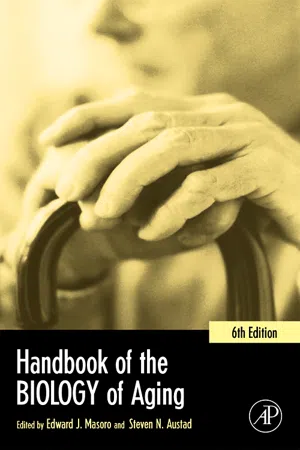
- 680 pages
- English
- PDF
- Available on iOS & Android
eBook - PDF
Handbook of the Biology of Aging
About this book
The Handbook of the Biology of Aging, Sixth Edition, provides a comprehensive overview of the latest research findings in the biology of aging. Intended as a summary for researchers, it is also adopted as a high level textbook for graduate and upper level undergraduate courses. The Sixth Edition is 20% larger than the Fifth Edition, with 21 chapters summarizing the latest findings in research on the biology of aging. The content of the work is virtually 100% new. Though a selected few topics are similar to the Fifth Edition, these chapters are authored by new contributors with new information. The majority of the chapters are completely new in both content and authorship. The Sixth Edition places greater emphasis and coverage on competing and complementary theories of aging, broadening the discussion of conceptual issues. Greater coverage of techniques used to study biological issues of aging include computer modeling, gene profiling, and demographic analyses. Coverage of research on Drosophilia is expanded from one chapter to four. New chapters on mammalian models discuss aging in relation to skeletal muscles, body fat and carbohydrate metabolism, growth hormone, and the human female reproductive system. Additional new chapters summarize exciting research on stem cells and cancer, dietary restriction, and whether age related diseases are an integral part of aging. The Handbook of the Biology of Aging, Sixth Edition is part of the Handbooks on Aging series, including Handbook of the Psychology of Aging and Handbook of Aging and the Social Sciences, also in their 6th editions.
Frequently asked questions
Yes, you can cancel anytime from the Subscription tab in your account settings on the Perlego website. Your subscription will stay active until the end of your current billing period. Learn how to cancel your subscription.
At the moment all of our mobile-responsive ePub books are available to download via the app. Most of our PDFs are also available to download and we're working on making the final remaining ones downloadable now. Learn more here.
Perlego offers two plans: Essential and Complete
- Essential is ideal for learners and professionals who enjoy exploring a wide range of subjects. Access the Essential Library with 800,000+ trusted titles and best-sellers across business, personal growth, and the humanities. Includes unlimited reading time and Standard Read Aloud voice.
- Complete: Perfect for advanced learners and researchers needing full, unrestricted access. Unlock 1.4M+ books across hundreds of subjects, including academic and specialized titles. The Complete Plan also includes advanced features like Premium Read Aloud and Research Assistant.
We are an online textbook subscription service, where you can get access to an entire online library for less than the price of a single book per month. With over 1 million books across 1000+ topics, we’ve got you covered! Learn more here.
Look out for the read-aloud symbol on your next book to see if you can listen to it. The read-aloud tool reads text aloud for you, highlighting the text as it is being read. You can pause it, speed it up and slow it down. Learn more here.
Yes! You can use the Perlego app on both iOS or Android devices to read anytime, anywhere — even offline. Perfect for commutes or when you’re on the go.
Please note we cannot support devices running on iOS 13 and Android 7 or earlier. Learn more about using the app.
Please note we cannot support devices running on iOS 13 and Android 7 or earlier. Learn more about using the app.
Yes, you can access Handbook of the Biology of Aging by Edward J. Masoro,Steven N. Austad in PDF and/or ePUB format, as well as other popular books in Medicine & Geriatrics. We have over one million books available in our catalogue for you to explore.
Information
Table of contents
- Front Cover
- Handbook of The Biology of Aging
- Copyright Page
- Contents
- Contributors
- Foreword
- Preface
- About the Editors
- Section I. Conceptual and Technical Issues
- Section II: Non-Mammalian Models
- Section III: Mammalian Models
- Author Index
- Subject Index